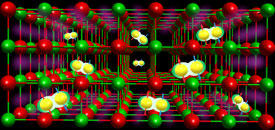

08/27/2018

© 2018 Kenichi Kaminaga
In an unexpected discovery, AIMR researchers have found that thin films of the compound lanthanum oxide (LaO) superconduct at temperatures below about 5 kelvin1. This opens up the possibility of using this oxide as a building block in novel superconductors made of superlattices — periodic structures consisting of layers of two or more materials.
Lanthanum oxide is not the most promising place to look for superconductivity. Samples made up of randomly orientated crystals were fabricated under high pressures in 1980 and found to conduct electricity like metals. The compound was largely forgotten about until high-temperature superconductivity was discovered in cuprate materials in the late 1980s. While one of these superconductors contained a molecular layer of lanthanum oxide, the layer itself was insulating.
Now, Tomoteru Fukumura of the AIMR at Tohoku University and his colleagues have made single-crystal thin films of rocksalt lanthanum oxide — so-called because it has the same crystal structure as sodium chloride, or common salt (see image) — and found that they superconduct.
“This discovery is both a surprise and a mystery,” says Fukumura. “It is a surprise that such a simple binary monoxide is superconducting — so far, only two other binary monoxides have been found to be superconductors. And it is a mystery because only thin films with a single-crystalline structure show superconductivity; thin films made up of randomly orientated crystals don’t exhibit superconductivity. We currently don’t have a good answer for this difference.”
The lanthanum oxide films superconduct at temperatures below about 5 kelvin (or −268 degrees Celsius). Although this does not sound very high, it is much higher than its cousins — other lanthanum monochalcogenides (that is, LaX, where X is sulfur, selenium or tellurium) all superconduct below 1.5 kelvin. It also bucks the trend established by these compounds: the temperature at which they start superconducting drops with decreasing mass, whereas lanthanum oxide, the lightest of them, has the highest superconducting transition temperature.
Fukumura’s team also found that lanthanum oxide’s transition temperature can be tuned by varying the strain in its crystal lattice.
The team is now trying to synthesize other binary monoxides and their superlattices, since combining them with lanthanum oxide promises to open up exciting possibilities, Fukumura notes. “For example, europium oxide is a well-known ferromagnetic semiconductor. By combining lanthanum oxide and europium oxide, we should be able to make new ferromagnetic superconductors, which could be useful for superconducting spintronics.” They have already succeeded in growing thin films of various rocksalt binary oxides, Fukumura adds. Such oxides could be used as building blocks for superlattices.
This research highlight has been approved by the authors of the original article and all information and data contained within has been provided by said authors.